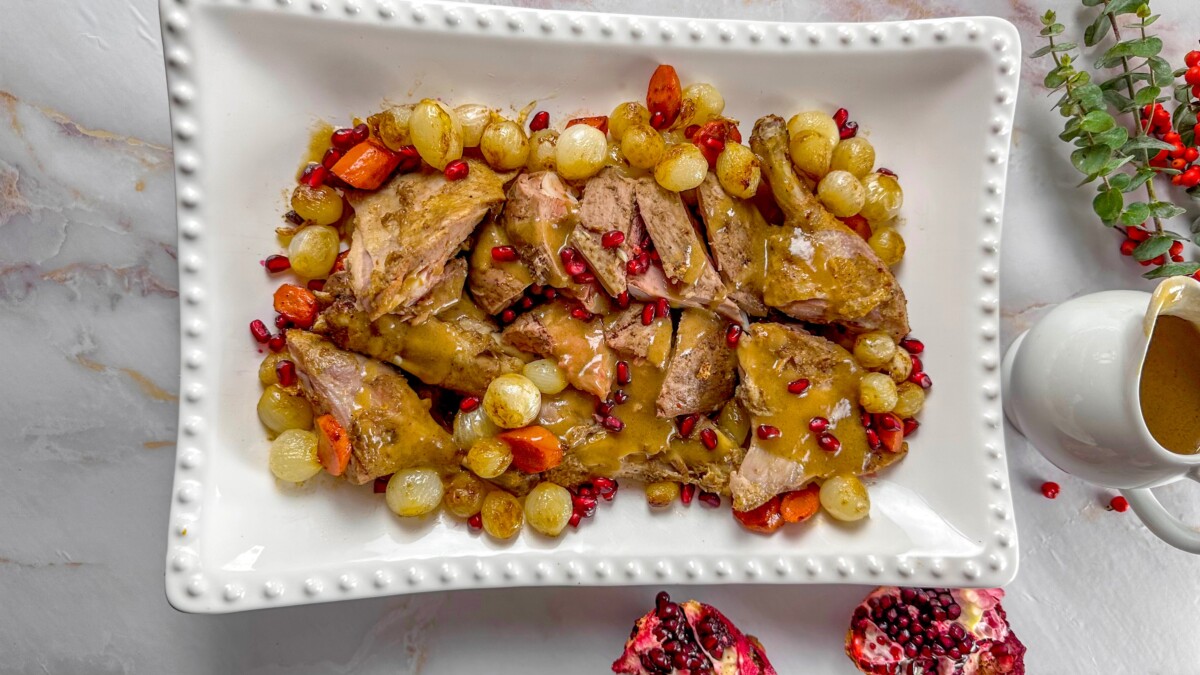Table of Contents
This roasted duck recipe is the key to making your guests happy and having them return for more! While the goal here isn’t crispy skin, it’s all about achieving the most tender and succulent meat possible. Enriched with a blend of wintery herbs like cinnamon and star anise, this roast duck is ideal for a memorable holiday treat. This classic dish t is best served with a bowl of homemade mashed potatoes, stuffing, or polenta.
Traditionally, the men in my family handled ducks, being the duck hunters. However, the first time I ventured into buying a duck from the market was for this very recipe, as our hunting season doesn’t commence until December—just in time for Christmas! With this straightforward recipe, you’ll master the art of creating a delicious and tender duck for the holidays in no time.
Key Ingredients for Tender Whole Roasted Duck
For the Duck:
- A whole duck is the dish’s star, known for its tender and flavorful meat.
- Fresh vegetables like onion, carrots, celery, and oranges infuse rich flavors into the duck.
- Aromatic spices such as star anise and cloves for a warm and fragrant profile.
For the Brine:
- A brine mixture of cold water, apple cider vinegar, and sugar enhances the duck’s juiciness and taste.
- Spices like cinnamon sticks, star anise, and bay leaves for added depth of flavor.
- The peels of oranges and their fresh juice for a citrusy kick, balanced with soy sauce.
For the Marinade:
- Fresh ginger and minced garlic for a zesty and aromatic base.
- Paprika and Aleppo pepper (or black pepper) for a hint of heat and smokiness.
- Sweet and tangy elements like pomegranate molasses, orange juice, and soy sauce.
- Olive oil to create a smooth and well-coated marinade.
For the Gravy:
- Duck drippings are a rich and savory base for the gravy.
- Butter and flour to create a roux for thickening and flavor.
- Broth added to the desired consistency for a luscious and flavorful gravy.
How To Prepare a Whole Duck?
A whole duck is big and heavy, but don’t let that steer you away from making it the centerpiece of your holiday dinner. Here’s the most foolproof way to prepare it.
- Remove the duck from its packaging and discard the plastic.
- Take the giblets out of the duck and set them aside. Giblets are the duck’s heart, liver, and gizzards. Giblets are an excellent flavor boost for preparing stocks and can also be pan-fried for a pre-dinner snack. If your family isn’t a fan of giblets, feel free to discard them.
- Scrub the duck skin with kosher salt, then rinse it with cold water. Dry the skin well with a paper towel.
- Cut any extra fat around the neck, bottom, and duck’s cavity.
- For this recipe, don’t cut into the duck’s skin. If you want a crispy duck, scoring the duck’s skin is a popular way to help render fat. Don’t pierce the skin to the meat if you decide to do this. Piercing the flesh will dry it out.
- After preparing the duck, submerge it in brine overnight or for 24 hours.
The Power of Brine for Your Whole-Roasted Duck
Brine is a magical mixture of salt, spices, and more salt, and it plays a significant role in elevating your roasted duck game. When you brine poultry, you add flavor and infuse the meat with the goodness of salt. It’s like a secret handshake that tenderizes the meat, ensuring it’s juicy and succulent when cooked.
For the ultimate duck experience, I recommend giving it a 24-hour brining session, or at the very least, letting it luxuriate overnight. But here’s the kicker: separating the fatty breast skin from the flesh before the brine bath is the game-changer. It allows the brine to penetrate the meat, making those breasts incredibly tender and flavorful. To do this, use the back of a wooden spoon to gently separate the skin from the meat, being careful not to tear it. Go slow and steady! Once your brine is prepared, here’s a top tip: ensure the duck is fully submerged by placing something heavy, like a plate, on top to prevent it from floating. Your duck will thank you later!
My Top Tips for Perfectly Roasting Your Duck:
Now that your duck has undergone its brining transformation, it’s time to bring it to a golden, flavorful finish in the oven. Brace yourself for the tantalizing aromas that will soon envelop your kitchen.
- Bring It to Room Temperature: Take your duck out of the fridge an hour before you start roasting. This step allows for more cooking.
- Rinse and Dry: Remove your duck from its brine and give it a good rinse in the sink. Then, pat it dry and let it reach room temperature.
- Prepare the Marinade: Assemble the marinade while your duck adjusts to room temperature. You’ll find the recipe below for your convenience.
- Aromatic Stuffing: Enhance the flavors by stuffing the duck’s cavity with aromatics like onions, carrots, celery, and an orange.
- Proper Roasting Setup: Place the duck on a flat rack, and add a few star anise to the roasting pan, along with about a cup and a half of water—just enough to cover the bottom of the pan. Then, generously coat the duck with the prepared marinade.
- Low and Slow: Roasting your duck at a lower temperature (275°F) for longer is the secret to achieving incredibly tender meat.
- Browning Glory: Cover the duck with parchment paper and foil initially. Uncover it once the internal temperature reaches 130°F, typically after about 45 minutes, allowing the skin to brown beautifully.
- Basting Magic: At 130°F internal temperature, use the flavorful stock from the bottom of the pan to baste the duck a few times during the final ten minutes of cooking.
- Temperature Check: I cook my duck until it reaches an internal temperature of 135°F. While the FDA recommends 165°F for chicken, duck carries a lower risk of salmonella, making it safe to cook to a temperature that suits your preference.
Now that you’ve roasted the duck, it’s time to carve and serve. But don’t worry; it is not as difficult as it seems! First, remove the wooden spears and the vegetables from the inside. Then, hold one of the legs by the end and use a sharp carving knife or shears to slice the leg from the body. Bend back the drumstick when your knife hits the bone, and the leg should come off quickly. Repeat with the other leg. Use your sharp knife or shears to cut off each wing. Slice or cut down the breastbone and separate it in two. Remove the breast from the bone by carefully sliding your knife as close as you can against the bone. Keep the carcass for stock!
Preparation



Oven Preparation: Preheat your oven to 275°F.


Cooking: Cover the duck first with parchment paper, then with foil. Roast for about 2 hours, or until the internal temperature reads 130°F. Remove the coverings, baste the duck with its drippings, and continue to roast until the internal temperature reaches 135°F.

Gravy: Strain the duck drippings into a bowl. In a saucepan, melt the butter, whisk in the flour to form a roux. Gradually whisk in the broth until the desired consistency is achieved. Season with salt and pepper to taste.
Ingredients:
Adjust Servings
| 1 whole 6 lb duck | |
| ½ onion (chopped) | |
| 2 carrots (peeled and chopped) | |
| 2 celery sticks (chopped) | |
| 1 orange (peeled and cut into chunks) | |
| 1 ½ cup water | |
| 3 star anise | |
| 5 whole cloves |
For the Brine:
| 8 cupe cold water | |
| 1/3 cup apple cider vinegar | |
| 1/2 cup sugar | |
| 1/2 cup kosher salt | |
| 2 cinnamon sticks | |
| 3 star anise | |
| 8 black pepper cones | |
| 5 bay leaves | |
| 2 oranges peels only | |
| 1/2 cup fresh orange juice | |
| 2 tablespoons soy sauce |
For the Marinade:
| 1 tablespoon minced ginger | |
| 2 tablespoons minced garlic | |
| 1 teaspoon paprika | |
| 1 teaspoon Aleppo pepper (or black pepper) | |
| 2 tablespoons pomegranate molasses | |
| 1/4 cup orange juice | |
| 2 tablespoons soy sauce | |
| 2 tablespoons olive oil |
For the Gravy
| Duck Drippings | |
| 4 tablespoons butter | |
| 2 tablespoons flour | |
| extra Broth if needed | |
| Salt and Pepper, for seasoning |
Preparation
Rana’s Notes!
Nutrition Information
The information shown is an estimate provided by an online nutrition calculator. It should should not be considered a substitute for a professional nutritionist's advice.
See our full nutrition disclosure here.







I would love to hear your experience!
Craving a unique and memorable centerpiece for your dinner table? Try this exquisite roasted whole duck recipe! If you love it as much as I do, don’t forget to leave a comment and share your experience!